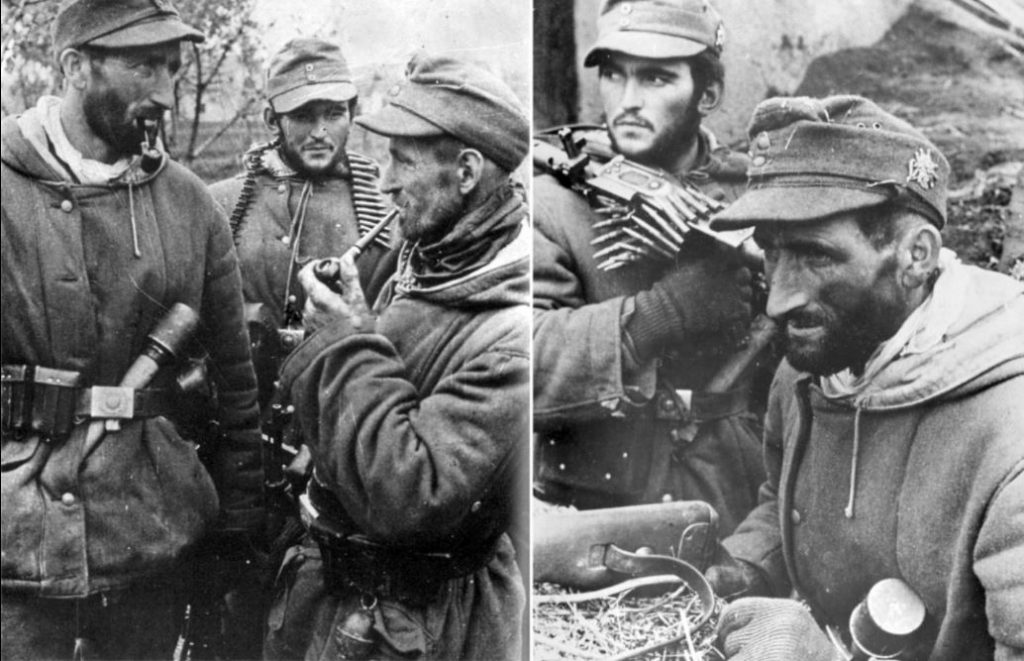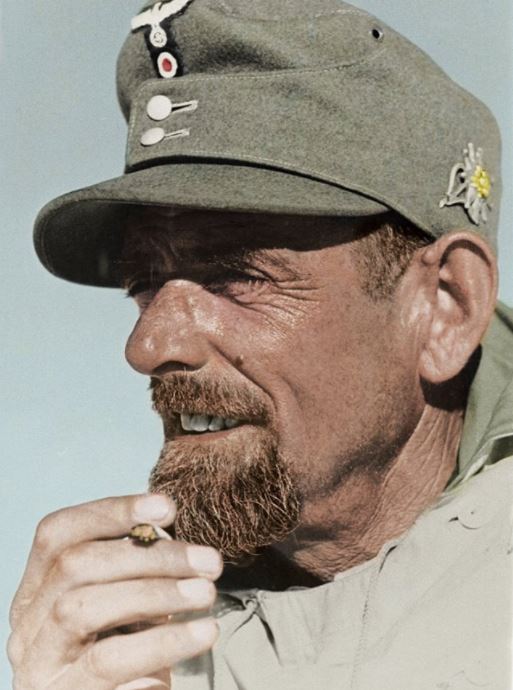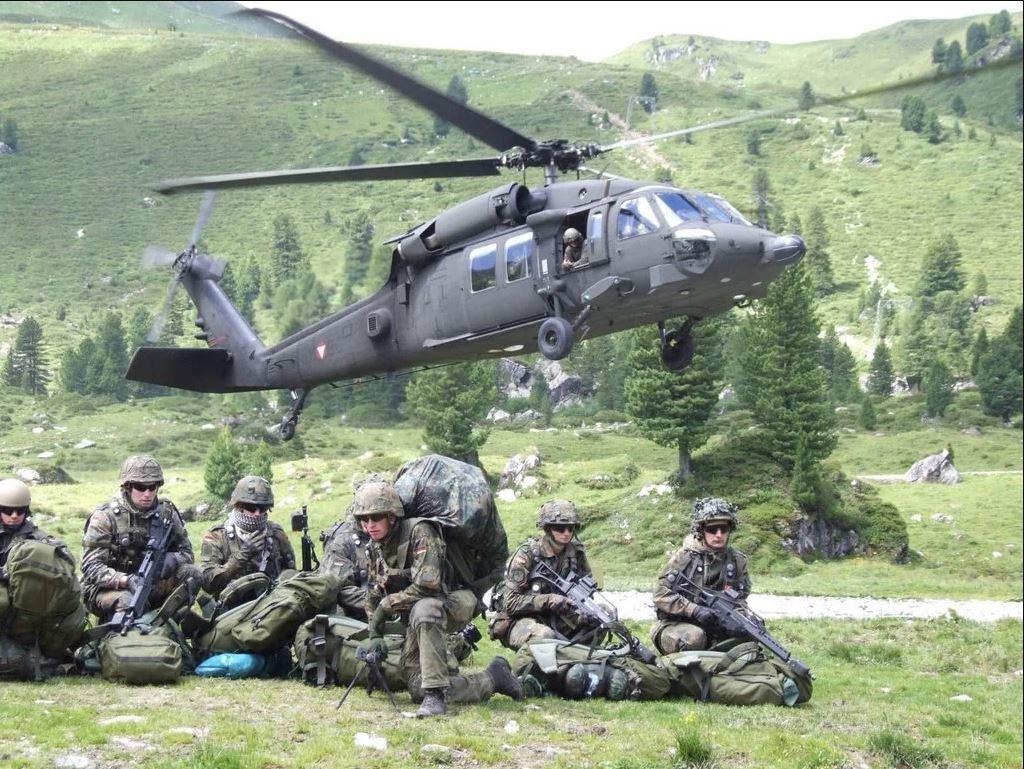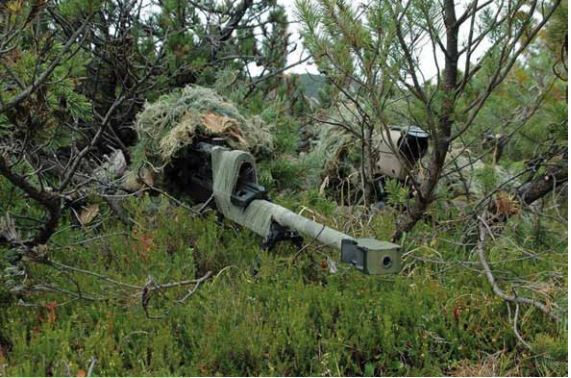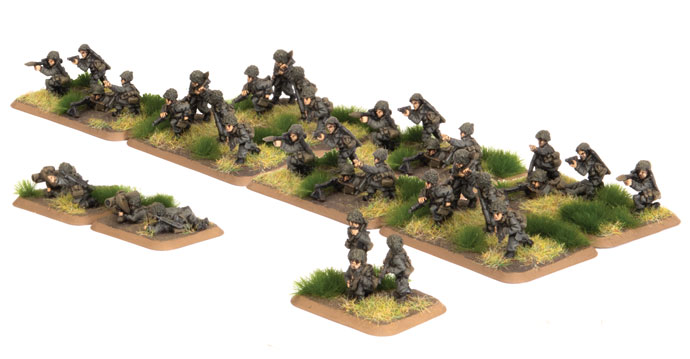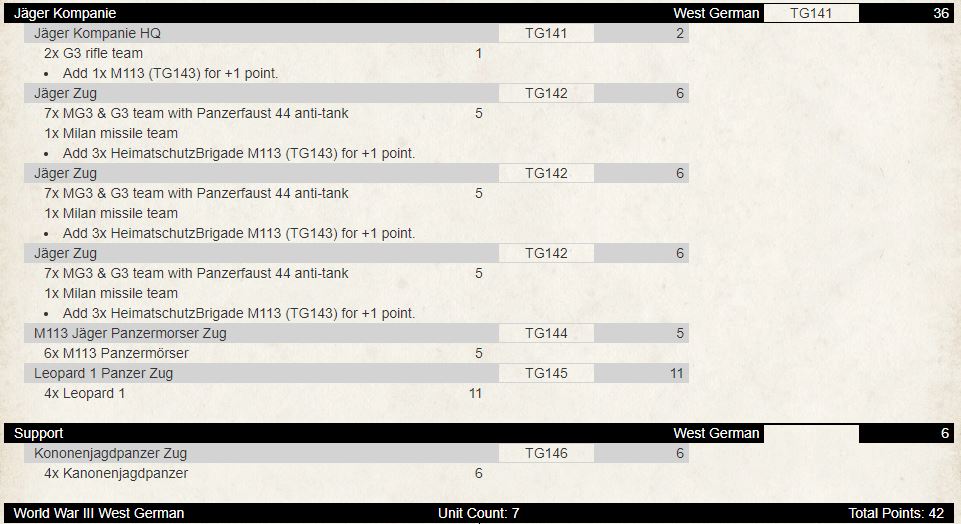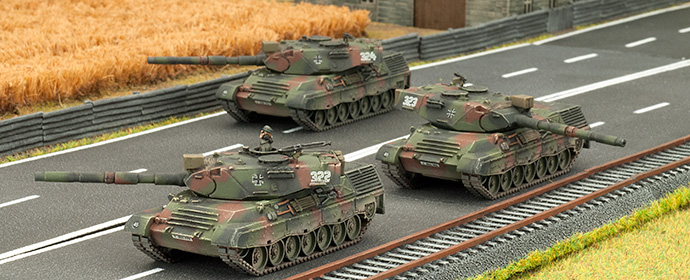Modern Gebirgsjäger – note the stocks used to provide a stable firing position
One of my first and favourite Flames of War German units is the Gebirgsjäger or Mountain light infantry. Originally they were the various alpine troops from Germany, Austria, and Switzerland as part of the Austro-Hungarian Empire, but the German units were formed as the German Alpenkorps during WWI. After hard fighting against similar elite units from the French (Chasseurs Alpins) and the Italians (Alpini) during the Mountain fighting on the Alpine Front, between German, French and Italian forces, they were given their own insignia, the edelweiss, and was later made into a metal lapel pin.
The Gebirgsjäger often wore the storied edelwiess flower on their uniform, which only grew high in the Alps and it was said: “the possession of one is a proof of unusual daring”. It was so popular with troops from these units that they would often have a dried flower somewhere on their uniform or their cap, as a symbol of bravery in lonely peaks and pure mountain air. Their motto was “Wo andere Aufhoren, fangen wir erst an!” – or “Where others stop, we get going!”
Gebirgsjäger in WWII – seems beards and pipes were mandatory
The incredibly tough fighting in high altitudes and freezing temperatures included drawn-out trench warfare, tunnelling through glacial ice and hard carbonate rock, as well as avalanches caused by shell fire. Casualties due to shellfire in this terrain were 70% higher than those in the soft mud of Belgium and France, due to rock shrapnel inflicting additional casualties. Also, the environment itself was hard on soldiers with frostbite and malnutrition generating even more casualties because of the difficulty re-supplying food, medical supplies, ammunition, and other provisions.
This type of mountain fighting also introduced new tactics and weapons, like the lightweight Gewehr 33/40 rifle in WWII, and many lightweight artillery pieces were introduced, called mountain guns, these typically were smaller or able to be broken up into many parts for easy transport via mules or as man-pack pieces. In WWII a German 10.5cm GebH 40 mountain howitzer was designed and produced, made with lightweight alloys, and able to be broken up into parts for mule transport. It was significant in that previously the largest mountain guns only had a barrel width of 75mm or less, and a larger 10.5cm calibre gun was not considered practical due to its weight and size. It was still in use until the 1960s and was considered one of the best mountain guns ever made, and it was used by multiple European countries.
The modern Gebirgsjäger was reformed in 1956 when the West German Bundeswehr was formed, where they were organized as the 1. Gebirgsdivision, and were mainly stationed to the south of West Germany, in the mountainous Bavarian region, to defend from Soviet attack through the Danube Valley or from the border shared with Austria if the Soviets ignored its neutrality. They are a specialist unit with their main tasks being, warfare in extreme conditions, winter warfare, warfare in urban terrain, and warfare in the arctic, mountain, and desert terrain. They also have traditionally a very close comradeship and a distinct esprit de corps, with a special perception of discipline which can be seen in a relatively informal relationship between officers and soldiers during normal day duty. For example, during WWII the Lieutenant General of the 5th Gebirgsdivision Julius Ringel (an Austrian), was called “Papa” Ringel by his men, showing the close relationship the officers had with their men.
Julius ‘Papa’ Ringel – was later promoted to General der Gebirgstruppe
In the 1985 period of Team Yankee, the Bundeswehr 1.Gebirgsdivision was part of 2 Korps in the South of West Germany (Bavaria) and consisted of, 23rd Gebirgsjäger Brigade, 22nd Panzergrenadier Brigade “Oberland”, 24th Panzer Brigade “Niederbayern”, 8th Gebirgsartillery Regiment and Heimatschützbrigade 56.
As far as equipment the 1.Gebirgsdivision had its own divisional Panzeraufklärungs Kompanie as well as Gepards and Fliegerfausts for anti-air capability, and the 8th Gebirgsartillery Regiment provided 227mm MARS and LARS Raketenwerfer batteries, as well as larger 203mm Sf M110 self-propelled artillery, and CL-89 rocket launched surveillance drones.
The equipment for the more mechanised parts of the Division, 22nd Panzergrenadier Brigade “Oberland” was equipped with Marders, Leopard 1s and M109G self-propelled artillery, and 24th Panzer Brigade “Niederbayern” was similar with Marders, Leopard 2s and M109G artillery. The Heimatschützbrigade 56 was the best equipped Heimatschützbrigade in the Bundeswehr, with Leopard 1’s, M109Gs, and a mix of Marder and M113 equipped Panzergrenadier Kompanies, and was really for all intents and purpose considered a line unit and not a reserve Heimatschützbrigade.
Troopers from the 23rd Gebirgsjäger Brigade – working with Austrian Jägerbrigade 6
The 23rd Gebirgsjäger Brigade, the actual unit carrying on the Gebirgsjäger tradition, was not mechanized like the other brigades in the 1.Gebirgsdivision, it was mainly a light infantry unit armed with Milan anti-tank missiles, but with larger platoon sizes than the smaller Panzer grenadier Zugs. It consisted in the 1980s of four standard Gebirgs Battalions and one Gebirgs Artillery Battalion, as well as its own Leopard 1 Panzer Kompanie and Pioneer Kompanie.
Each Battalion had a heavy support Kompanie with six M113 Panzermörsers, six twin-20mm Flak cannons, and a small Milan anti-tank Zug of six launchers. But interestingly they still use mules to help transport their heavy equipment in mountainous terrain, so another tradition that while old still works.
Another unique feature of the 23rd Gebirgsjäger Brigade was their Hochgebirgsjägerzüg, or High Mountain Jäger Zugs, an elite force inside the already specialized Gebirgsjäger Brigade. To qualify they must have excellent fitness, endurance, as well as alpine and skiing skills, with a range of tasks that go beyond even the usual tasks of the mountain troops. These included high-altitude reconnaissance, mountain rescue, and advanced mountaineering skills.
A Hochgebirgsjägerzüg sniper team
These high-altitude alpine Special Forces troops are trained to attack, defend, and survive in the harshest of terrain. They are also trained in ambushing, specialized sniper skills, surveillance, and hunter-killer groups, and there was only ever one Zug per Battalion, which was part of the HQ Kompanie. They were also to be used as a quick reaction blocking force and were allocated either CH-53G Sea Stallion or UH-1 Huey helicopters, to quickly deploy them high in the mountain passes. They would then set up in bottlenecks as an ambush force, or to report on enemy movements, they were even able to quickly and easily deploy Milan teams to help stop any heavy vehicles that did make it up to the alpine areas.
So how does all this translate into WWIII West German?? Well for me this force is one of the best, if not the best, West German infantry formations that you can get. It is excellent for a defensive stance, with each Gebirgsjäger Zug containing 9 stands: 7 – MG3 & G3 teams with panzerfaust 44 anti-tank weapons and 2 Milan missile teams. You can also take up to four Gebirgsjäger Zugs, rather than the three Zugs usually available to other West German infantry Kompanies, which makes it very durable due to its large platoon size and more Zugs.
Additionally, it is one of the larger West German infantry formations, with 10 units in the formation. A HQ, up to 4 Gebirgsjäger zugs, 2 Luchs Zugs, a Gebirgspanzerjäger Leopard 1 Zug, a panzermörser Zug and a Gepard AA Zug. The Leopard 1 Gebirgspanzerjäger Zug is unique in that instead of having the Jaguar 1 or 2 that other formations would have as their tank hunter platoons, the Gebirgsjäger had Kanonenjagdpanzers until 1984, when they were replaced with a Kompanie of 17 Leopard 1 tanks. It has an HQ of 2 tanks, and 3 Zugs of 5 Leopard 1 tanks each. So the Gebirgspanzerjager Zug has up to 5 Leopard 1 tanks instead of the normal 4 tanks Zug.
Another thing to not forget is their special Mountaineers rule, which allows them to cross previously impassable terrain like cliffs or embankments. Teams that start their movement turn adjacent to a cliff or mountainside (or other similar terrains) can roll a skill test, if passed they may move across the terrain with their terrain dash speed of 8”. This can be used to surprise an enemy which may have forgotten this, so keep that in mind when you need to assault an enemy position.
All of this makes the formation when fully fleshed out the largest in the West German book. At full strength, it can have, 37 infantry stands (including 8 Milan teams), 5 Leopard 1s, 4 Luchs, 6 Panzermörsers, 6 Gepards (not to mention another 6 Fliegerfaust Redeye teams if wanted), for a total of 41 infantry/weapons teams, and 21 vehicles. The infantry when dug in will be hard to dislodge, and has the numbers to take casualties.
If you wanted to represent the Hochgebirgsjägerzüg ( I know I want to), you can either take it as a smaller Gebirgsjäger Zug ( 5 MG3 & G3 teams, 1 Milan) or take a Fallschirmjager Zug as a support option, which is the same size but allows you to take two helicopters for 2 extra points. Now the Gebirgsjäger used either CH-53G Sea Stallion helicopter or UH-1 Huey, the Sea Stallion is huge and would be impressive, but the BF UH-1 Huey is excellent and easier to obtain. I can see myself researching up paint scheme for West German helicopters now…… and most likely it’s a start on a Fallschirmjager list as well…..
So I have put together a 100 point list with the new Gebirgsjäger formation, it seems reasonably tanky, with 3 large Gebirgsjäger Zugs, totalling 6 Milans, to hold positions and should be able to take a beating. I have also taken a small Fuchs Panzeraufklärungs Kompanie for two reasons, one is it adds an extra formation, so more resilience for your force, and it was the same cost to get the units in this than to get another large Gebirgsjäger Zug. It adds 2 small Zugs with a Milan each and a Luchs troop to spearhead and harass artillery and AA.
The extra Milans always help, and splitting them into two platoons means it’s two targets the enemy needs to target and take out, and if they ignore them because they are small I win then too. This gives me 8 Milan teams in total, which does not compare to how many the British can pump out, but it is still significant. The Milan is a very good AT weapon and can take out most armour, but it will have trouble with more expensive NATO tanks like the M1a1, Challengers, and Soviet T80.
For this reason, I took a small PAH flight with the AT23 HOT missiles. Normally I find them overpriced for their use, but as I cannot take Jaguar 1s in this formation, and Leopard 2s of both types are too expensive for this formation, this is the only way I can get HOT missiles to try and attack high armour enemy tanks frontally. The best way to use these is as mobile flankers, using your Hunter killer pop-up attacks around terrain, but as you cannot move and shoot they often are only firing once every two turns unless you place them carefully at the start of the game. The only thing you need to be aware of is the AA umbrella of your enemy and enemy aircraft, so try to keep out of enemy AA range, and also make sure your AA can support you if enemy aircraft try to take them out.
For artillery support, you have the M113 Panzermörsers, great against dug-in infantry and low top armour units like AA and self-propelled artillery. Even if you range in, and have a low chance to do damage, it may make a WARSAW PACT artillery unit move to get out of under the template, so it will lose its range in marker, which can be hard for it to do again. You also have LARS which is similar but can also drop minelets to restrict or channel the movement of the enemy. I also always take 4 Tornados, which have excellent cluster munitions but are easy to kill being hit on 4+ and only a 5+ save, so try to destroy any AA before you bring them in, or you will take casualties…. but sometimes it is worth it, AT8 death from above is no joke!!
Lastly, we have one of my other favourites, the cheap and cheerful Leopard 1, with excellent mobility, a moving RoF of 2, and stabilizers. It is an excellent flanker, still able to punch holes in the sides of more expensive top tier tanks with its AT19 main gun. Also as it is not HEAT like many other similar tanks, the enemy tanks won’t get buffs to its side armour with Chobham, ERA, and bazooka skirts, so make sure you make use of your movement orders to get those flank shots in. Also when combined with a unit of Gepards, you will make short work of enemy IFVs if they let you.
This force will be a very different play style to most West German forces from the older Leopard book, so it will take a few games to get used to. But I think it offers some much-needed variety to a West German force, and I really look forward to playing with the new options it can give you. I do look forward to finally being able to hold a position against other enemy infantry, these guys will be a hard nut to crack, especially in defensive scenarios with extra minefields, you will be able to channel the enemy into your kill zones.
So have a look yourself and see what you can make of it, and hopefully, you can even use your Mountaineers special rule, I would be making that a gaming life goal for myself!! Remember – Where others stop, we get going!
~ Adam


